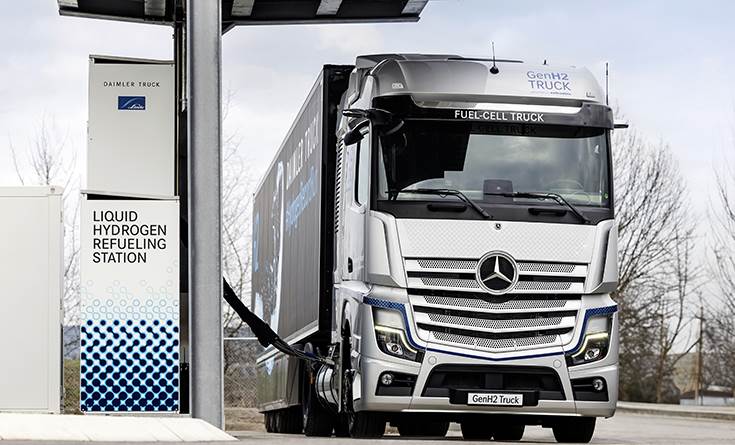Daimler Truck and Linde Engineering have reached an important milestone in hydrogen infrastructure on the way to decarbonizing transportation. In recent years, engineers from both companies have worked together to develop sLH2 technology, a new process for handling liquid hydrogen.
Compared to gaseous hydrogen, this innovative approach allows for higher storage density, longer range, faster refueling, lower costs and improved energy efficiency. It takes about 10-15 minutes to refuel a 40-tonne heavy-duty truck with 80 kilograms of liquid hydrogen. This enables a range of 1,000 kilometres and more. At the same time, the new sLH2 technology reduces the required investment for a hydrogen filling station by a factor of two to three, and operating costs are about five to six times lower. Today, liquid hydrogen can be reliably supplied throughout Europe.

Compared to conventional liquid hydrogen (LH2) refuelling technology, the new process uses a new sLH2 pump to slightly increase the pressure of the liquid hydrogen. Through this method, the hydrogen becomes subcooled liquid hydrogen (sLH2). In this state, the result is a very robust and stable refuelling process, which reduces energy losses during refuelling to a minimum. In addition, no data transmission between the filling station and the vehicle is necessary, which further reduces the complexity of the refuelling process. At the same time, refuelling capacity will be increased to a new level. The filling station has a capacity of 400 kg of liquid hydrogen per hour. Compared to conventional refueling with liquid or gaseous hydrogen, sLH2 is much simpler and at the same time offers higher performance.
With the aim of establishing a common refuelling standard for hydrogen-powered trucks, the technology will be made available to all interested parties via an ISO standard. Andreas Gorbach, Member of the Board of Management of Daimler Truck, and Jürgen Nowicki, Chairman of the Board of Management of Linde Engineering, opened the first public sLH2 pilot station on February 7 in Wörth am Rhein with the refuelling of a Mercedes-Benz GenH2 truck.
Andreas Gorbach, Member of the Board of Management of Daimler Truck AG, responsible for Truck Technology said: “To decarbonize transport, we need three factors: the right battery and hydrogen trucks, the necessary infrastructure, and cost parity between zero-emission and diesel vehicles. The transformation of vehicles is in full swing. Today, we have reached an important milestone in hydrogen infrastructure: thanks to the sLH2 standard, refuelling with hydrogen is as easy as with diesel – in about 10 to 15 minutes, the tank is full for a range of over 1,000 km. We are now calling on other truck manufacturers and infrastructure companies to follow our approach and work together to make this technology the industry standard!”
Jürgen Nowicki, Executive Vice President Linde plc and CEO of Linde Engineering, said: “sLH2 significantly increases the efficiency of hydrogen refuelling facilities. The required investments are reduced by a factor of two to three and operating costs are reduced by a factor of five to six. These and other advantages make sLH2 a practical, CO2-neutral alternative to diesel refuelling in heavy-duty transport. The technology we developed together with Daimler Truck paves the way for the nationwide refueling infrastructure that today’s logistics chains depend on.”

sLH2 filling station sets the efficiency benchmark for liquid hydrogen
The new public sLH2 filling station in Wörth am Rhein sets standards in terms of energy efficiency and performance. With an energy consumption of only 0.05 kWh/kg, it requires about 30 times less energy compared to conventional refuelling with gaseous hydrogen. The filling station also has a very small footprint of only 50 square metres (excluding the fuel pump) and allows configurations in which several pumps are possible for the parallel refuelling of trucks as well as the refuelling of several vehicles one after the other. The liquid hydrogen storage tank has a capacity of four tonnes, which is sufficient for about ten hours of continuous refuelling. In addition, the capacity of the sLH2 filling station can be increased to over eight tonnes per day by refilling in the meantime.
Daimler Truck and Linde Engineering want to make sLH2 the leading hydrogen refuelling technology for heavy-duty trucks. Therefore, both companies offer a high degree of transparency and openness around the relevant interfaces of the jointly developed sLH2 technology. The technology has been standardized in an open ISO process and is freely accessible to all interested parties. Daimler Truck and Linde Engineering are now calling on other OEMs, infrastructure companies and associations to apply the new liquid hydrogen standard and thus establish a global mass market for the process.

Safe, fast and easy refuelling of hydrogen
In contrast to conventional liquid hydrogen (LH2) refuelling, the sLH2 process is similarly convenient to today’s diesel refuelling technology. Thanks to the robust insulation of the refuelling hose and the design of the interfaces between the nozzle and the fuel tank, the refuelling process is extremely safe and prevents hydrogen leakage. Therefore, the protective measures required for refuelling with sLH2 are comparable to those for diesel. During the refuelling process, liquid hydrogen can be filled into two connected 40 kg tanks on either side of the truck chassis at minus 253 degrees Celsius, without the need for special safety equipment. The sLH2 technology enables a high flow rate of more than 400 kg of hydrogen per hour, and the filling of 80 kg of liquid hydrogen can be completed in ten to fifteen minutes. Finally, the new process avoids the so-called boil-off effect: In conventional refuelling with liquid hydrogen, part of the hydrogen becomes gaseous and has to be extracted at great expense with a second pipe. In the sLH2 process, the hydrogen remains liquid during refuelling, so only one nozzle is needed to fill the tanks. This simplifies handling and reduces investment costs. The new filling station in Wörth will be supplied with liquid hydrogen by Linde. Linde operates the world’s largest hydrogen production and distribution infrastructure.
